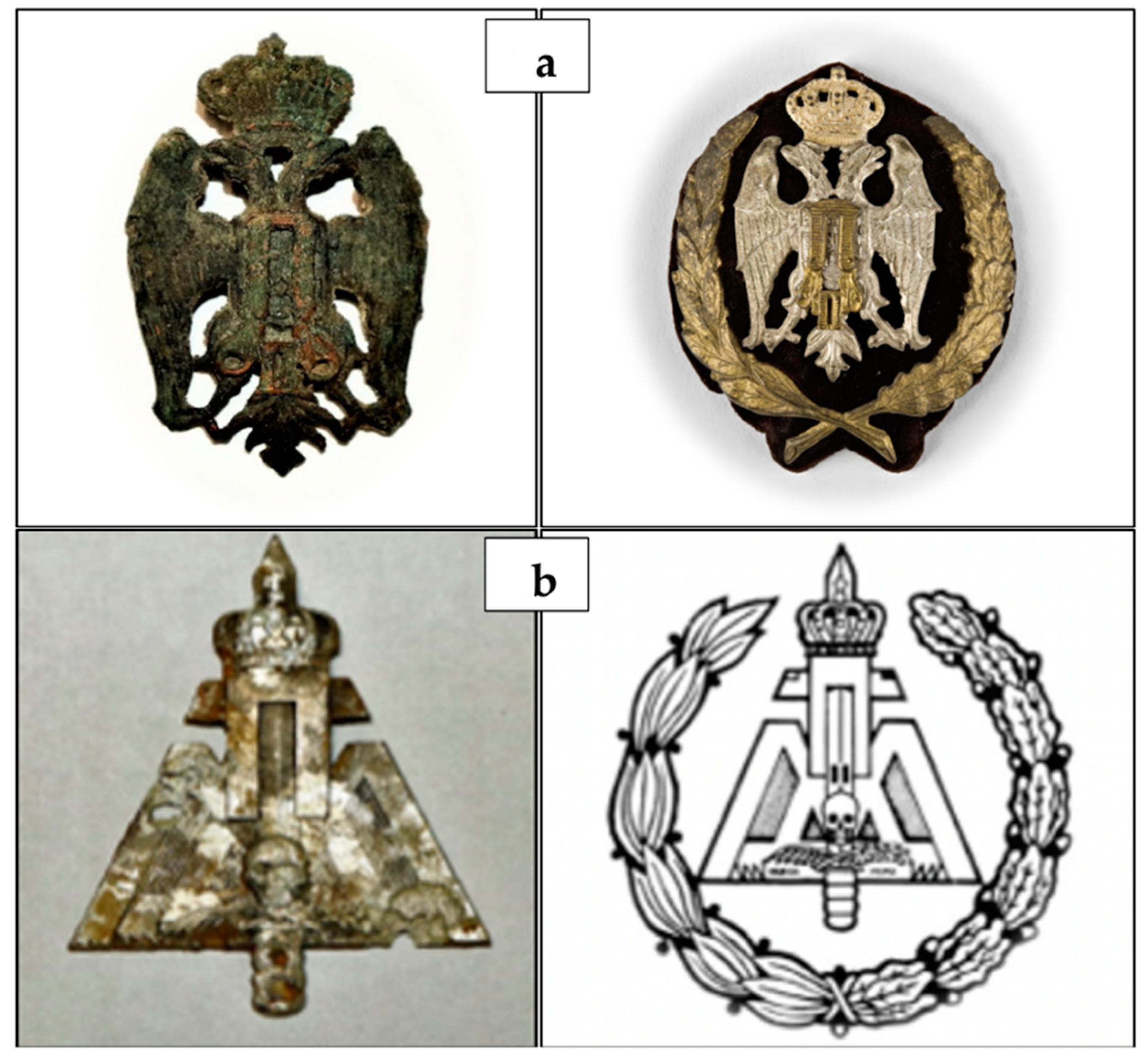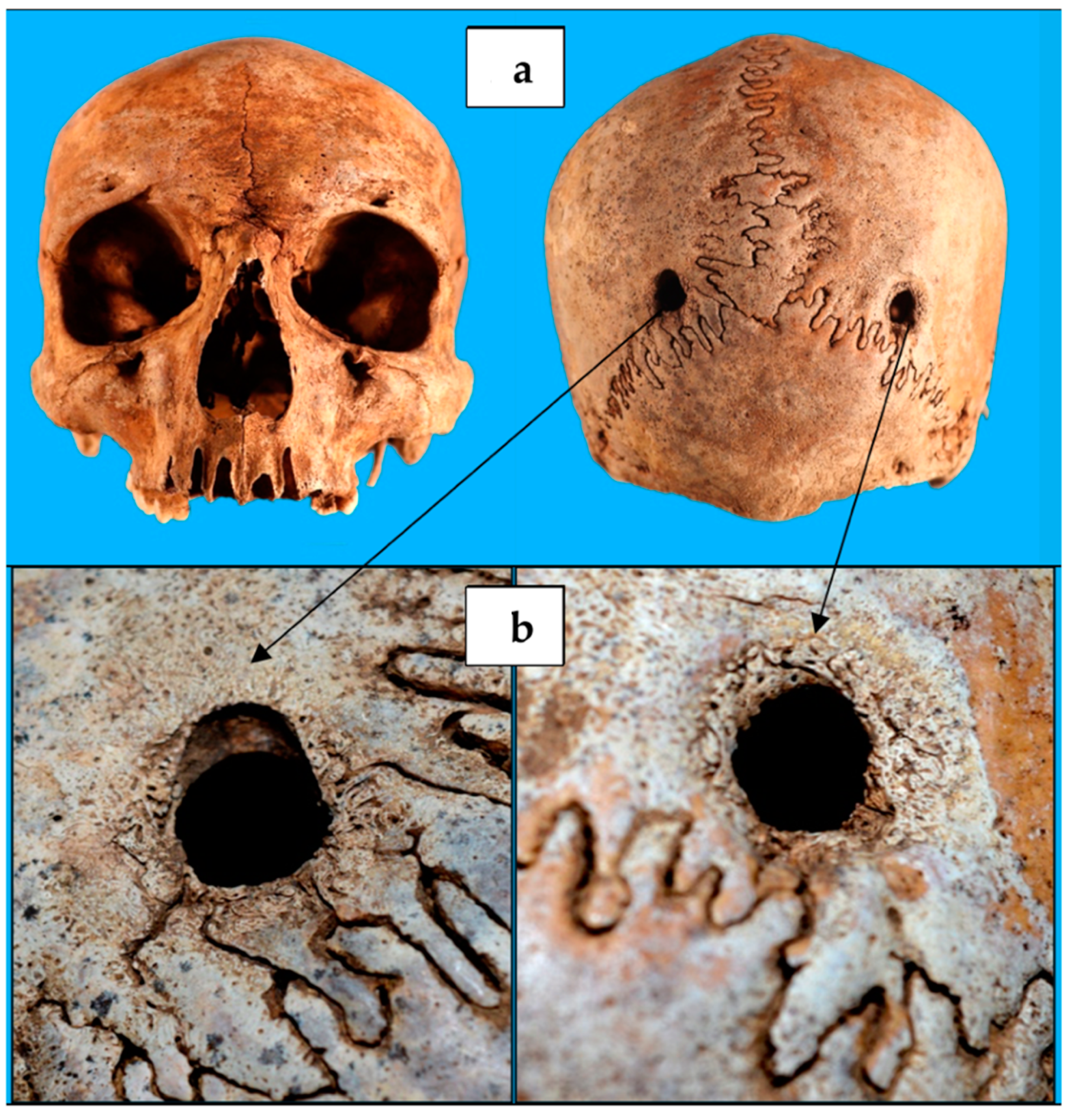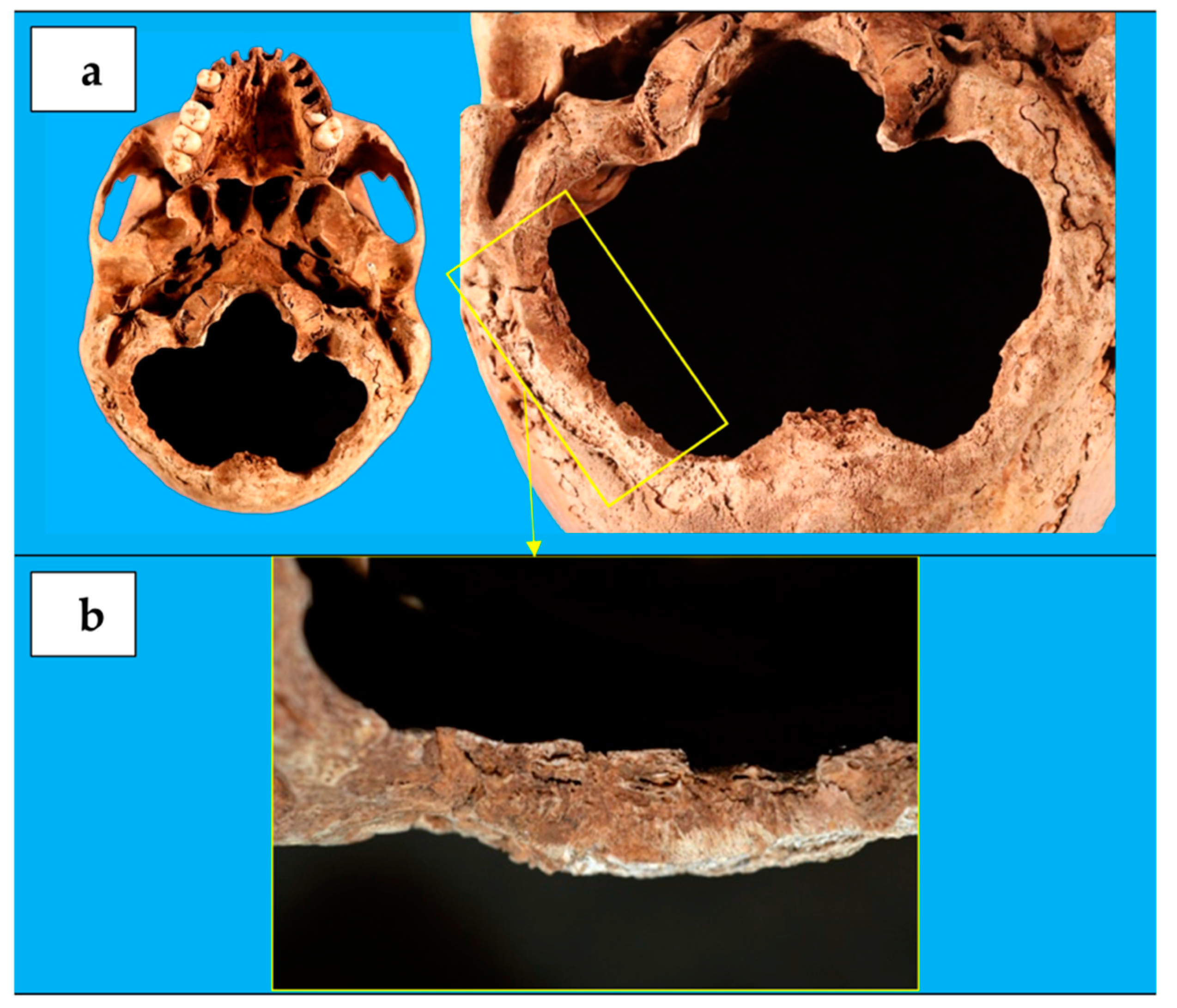Torkildsen’s Ventriculocisternostomy First Applications: The Anthropological Evidence of a Young Slavic Soldier Who Died in the Torre Tresca Concentration Camp (Bari, Italy) in 1946
Abstract
:Simple Summary
Abstract
1. Introduction
2. Materials and Methods
3. Results
4. Discussion
5. Conclusions
Author Contributions
Funding
Institutional Review Board Statement
Informed Consent Statement
Data Availability Statement
Conflicts of Interest
References
- Chamberlain, A. Morbid Osteology: Evidence for Autopsies, Dissection and Surgical Training from the Newcastle Infirmary Burial Ground (1753–1845). In Anatomical Dissection in Enlightenment England and Beyond: Autopsy, Pathology and Display; Mitchell, P.D., Ed.; Ashgate: Farnham, UK, 2012; pp. 11–22. [Google Scholar]
- Dittmar, J.M.; Mitchell, P.D. A new method for identifying and differentiating human dissection and autopsy in archaeological human skeletal remains. J. Archaeol. Sci. Rep. 2015, 3, 73–79. [Google Scholar] [CrossRef]
- Moraitis, K.; Eliopoulos, C.; Spiliopoulou, C. Fracture characteristics of perimortem trauma in skeletal material. Internet J. Biol. Anthropol. 2008, 3, 431–440. [Google Scholar]
- Aufderheide, A.C.; Rodríguez-Martín, C. Skeletal Evidence of Trauma: Part 3. In The Cambridge Encyclopedia of Human Paleopathology; Cambridge University Press: Cambridge, UK, 2011; pp. 31–34. [Google Scholar]
- Arena, F.; Larocca, F.; Gualdi-Russo, E. Cranial Surgery in Italy During the Bronze Age. World Neurosur. 2021, 157, 36–44. [Google Scholar] [CrossRef] [PubMed]
- Verano, J.W.; Finger, S. Ancient Trepanation. In Handbook of Clinical Neurology; Finger, S., Boller, F., Tyler, K.L., Eds.; Elsevier: Amsterdam, The Netherlands, 2010; Volume 95, pp. 3–14. [Google Scholar]
- Verano, J.W. Reprint of-Differential diagnosis: Trepanation. Int. J. Paleopathol. 2017, 19, 111–118. [Google Scholar] [CrossRef] [PubMed]
- Pavlovic, T.; Djonic, D.; Byard, R.W. Trepanation in archaic human remains—characteristic features and diagnostic difficulties. Forensic Sci. Med. Path. 2020, 16, 195–200. [Google Scholar] [CrossRef] [PubMed]
- Eide, P.K.; Lundar, T. Arne Torkildsen and the ventriculocisternal shunt: The first clinically successful shunt for hydrocephalus. J. Neurosurg. 2016, 124, 1421–1428. [Google Scholar] [CrossRef] [PubMed] [Green Version]
- Giacomo, S. Il Bosco dopo il Mare. Partigiani Italiani in Jugoslavia, 1943–1945, 1st ed.; Infinito Editori: Modena, Italy, 2009; p. 125. [Google Scholar]
- Simon, T. Britain, Mihailovic, and the Chetniks, 1941-42; Palgrave Macmillan: London, UK, 1998; pp. 17–30. [Google Scholar]
- Powers, N. Human Osteology Method Statement. Museum of London. Available online: https://www.museumoflondon.org.uk/application/files/4814/5633/5269/osteology-method-statement-revised-2012.pdf (accessed on 28 September 2021).
- Buikstra, J.E.; Ubelaker, D.H. Standards for Data Collection from Human Skeletal Remains; Arkansas Archeological Survey Reserach Series: Fayetteville, NC, USA, 1994; p. 44. [Google Scholar]
- McKern, T.W.; Stewart, T.D. United States. Army. Quartermaster Research & Development Command; Quartermaster Research and Development Center (U.S.); Environmental Protection Research Division. In Skeletal Age Changes in Young American Males: Analysed from the Standpoint of Age Identification; National Government Publication: Natik, MA, USA, 1957; p. 45. [Google Scholar]
- Nemeskéri, J.; Harsányi, L.; Acsädi, G. Methoden zur Diagnose des Lebensalters von Skelettfunden. Anthropologischer 1960, 24, 103–115. [Google Scholar]
- Lovejoy, C.O. Dental Wear in Libben Population: Its Functional Pattern and Role in the Determination of Adult Skeletal Age at Death. Am. J. Phys. Anthrop. 1985, 68, 47–56. [Google Scholar] [CrossRef] [PubMed]
- Brooks, S.; Suchey, J.M. Skeletal age determination based on the os pubis: A comparison of the Acsádi-Nemeskéri and Suchey-Brooks methods. Hum. Evol. 1990, 5, 227–338. [Google Scholar] [CrossRef]
- Schmitt, A.; Murail, P.; Cunha, E.; Rougé, D. Variability of the pattern of aging on the human skeleton: Evidence from bone indicators and implications on age at death estimation. J. Forensic Sci. 2002, 47, 1203–1209. [Google Scholar] [CrossRef]
- Buckberry, J.L.; Chamberlain, A.T. Age estimation from the auricular surface of the ilium: A revised method. Am. J. Phys. Anthropol. 2002, 119, 231–239. [Google Scholar] [CrossRef] [PubMed]
- Meindl, R.S.; Lovejoy, C.O. Ectocranial suture closure: A revised method for the determination of skeletal age at death based on the lateral-anterior sutures. Am. J. Phys. Anthropol. 1985, 68, 57–66. [Google Scholar] [CrossRef]
- Trotter, M.; Gleser, G.C. A re-evaluation of estimation of stature based on measurements of stature taken during life and of long bones after death. Am. J. Phys. Anthropol. 1958, 16, 79–123. [Google Scholar] [CrossRef]
- Martin, R.; Saller, K. Lehrbuch der Anthropologie, 7th ed.; Gustav Fischer Verlag: Frankfurt, Germany, 1958; p. 62. [Google Scholar]
- Cattaneo, C.; Cappella, A.; Cunha, E. Post Mortem Anthropology and Trauma Analysis. In P5 Medicine and Justice; Ferrara, S.D., Ed.; Springer: Berlin, Germany, 2017; pp. 166–179. [Google Scholar]
- Sauer, N. The Timing of Injuries and Manner of Death: Distinguishing Among Antemortem, Perimortem and Postmortem Trauma. In Forensic Osteology: Advances in the Identification of Human Remains; Reichs, K., Ed.; Charles C Thomas Publisher: Springfield, MA, USA, 1998; pp. 321–332. [Google Scholar]
- De Boer, H.H.; Van der Merwe, A.E.; Hammer, S.; Steyn, M.; Maat, G.J.R. Assessing post-traumatic time interval in human dry bone. Int. J. Osteoarchaeol. 2012, 25, 98–109. [Google Scholar] [CrossRef]
- Rinaldo, N.; Zedda, N.; Bramanti, B.; Rosa, I.; Gualdi-Russo, E. How reliable is the assessment of Porotic hyperostosis and Cribra Orbitalia in skeletal human remains? A methodological approach for quantitative verification by means of a new evaluation form. Archaeol. Anthropol. Sci. 2019, 11, 3549–3559. [Google Scholar] [CrossRef]
- Oxenham, M.F.; Cavill, I. Porotic hyperostosis and cribra orbitalia: The erythropoietic response to iron-deficiency anaemia. Anthropol. Sci. 2010, 118, 199–200. [Google Scholar] [CrossRef] [Green Version]
- Walker, P.L.; Bathurst, R.R.; Richman, R.; Gjerdrum, T.; Andrushko, V.A. The causes of porotic hyperostosis and cribra orbitalia: A reappraisal of the iron-deficiency-anemia hypothesis. Am. J. Biol. Anthropol. 2009, 139, 109–125. [Google Scholar] [CrossRef] [PubMed]
- Scianò, F.; Bramanti, B.; Manzon, V.S.; Gualdi-Russo, E. An investigative strategy for assessment of injuries in forensic anthropology. Leg. Med. 2020, 42, 101632. [Google Scholar] [CrossRef] [PubMed]
- Lovell, N.C. Trauma analysis in paleopathology. Yerbk Am. J. Phys. Anthropol. 1997, 40, 139–170. [Google Scholar] [CrossRef]
- Aschoff, A.; Kremer, P.; Hashemi, B.; Kunze, S. The scientific history of hydrocephalus and its treatment. Neurosurg. Rev. 1999, 22, 67–93. [Google Scholar] [CrossRef] [PubMed]
- Pennybacker, J. Obstructive hydrocephalus. Ann. R. Coll. Surg. Engl. 1953, 12, 51–62. [Google Scholar] [PubMed]
- Morone, P.; Dewan, M.C.; Zuckermannm, S.L.; Tubbs, R.S.; Singer, R.J. Craniometrics and Ventricular Access: A Review of Kocher’s, Kaufman’s, Paine’s, Menovksy’s, Tubbs’, Keen’s, Frazier’s, Dandy’s, and Sanchez’s Points. Oper. Neurosurg. 2020, 18, 461–469. [Google Scholar] [CrossRef] [PubMed]
- Dandy, W.E. Ventriculography following the injection of air into the cerebral ventricles. Ann. Surg. 1918, 68, 5–11. [Google Scholar] [CrossRef] [PubMed]
- Torkildsen, A. The gross anatomy of the lateral ventricles. J. Anat. 1934, 68, 480–491. [Google Scholar] [PubMed]
- Scarff, J.E. Treatment of hydrocephalus: An historical and critical review of methods and results. J. Neurol. Neurosurg. Psychiatry 1963, 26, 1–26. [Google Scholar] [CrossRef] [Green Version]
- Torkildsen, A. A new palliative operation in cases of inoperable occlusion of the sylvian aqueduct. Acta Psychiatr. Scand. 1939, 14, 221. [Google Scholar] [CrossRef]
- Jackson, I.J. A review of the surgical treatment of internal hydrocephalus. J. Pediatr. 1951, 38, 251–258. [Google Scholar] [CrossRef]
- Steyn, M.; De Boer, H.H.; Van der Merwe, A.E. Cranial trauma and the assessment of posttraumatic survival time. Forensic Sci. Int. 2014, 244, 25–29. [Google Scholar] [CrossRef]



Publisher’s Note: MDPI stays neutral with regard to jurisdictional claims in published maps and institutional affiliations. |
© 2021 by the authors. Licensee MDPI, Basel, Switzerland. This article is an open access article distributed under the terms and conditions of the Creative Commons Attribution (CC BY) license (https://creativecommons.org/licenses/by/4.0/).
Share and Cite
Sablone, S.; Gallieni, M.; Leggio, A.; Cazzato, G.; Puzo, P.; Santoro, V.; Introna, F.; De Donno, A. Torkildsen’s Ventriculocisternostomy First Applications: The Anthropological Evidence of a Young Slavic Soldier Who Died in the Torre Tresca Concentration Camp (Bari, Italy) in 1946. Biology 2021, 10, 1231. https://doi.org/10.3390/biology10121231
Sablone S, Gallieni M, Leggio A, Cazzato G, Puzo P, Santoro V, Introna F, De Donno A. Torkildsen’s Ventriculocisternostomy First Applications: The Anthropological Evidence of a Young Slavic Soldier Who Died in the Torre Tresca Concentration Camp (Bari, Italy) in 1946. Biology. 2021; 10(12):1231. https://doi.org/10.3390/biology10121231
Chicago/Turabian StyleSablone, Sara, Massimo Gallieni, Alessia Leggio, Gerardo Cazzato, Pasquale Puzo, Valeria Santoro, Francesco Introna, and Antonio De Donno. 2021. "Torkildsen’s Ventriculocisternostomy First Applications: The Anthropological Evidence of a Young Slavic Soldier Who Died in the Torre Tresca Concentration Camp (Bari, Italy) in 1946" Biology 10, no. 12: 1231. https://doi.org/10.3390/biology10121231
APA StyleSablone, S., Gallieni, M., Leggio, A., Cazzato, G., Puzo, P., Santoro, V., Introna, F., & De Donno, A. (2021). Torkildsen’s Ventriculocisternostomy First Applications: The Anthropological Evidence of a Young Slavic Soldier Who Died in the Torre Tresca Concentration Camp (Bari, Italy) in 1946. Biology, 10(12), 1231. https://doi.org/10.3390/biology10121231








